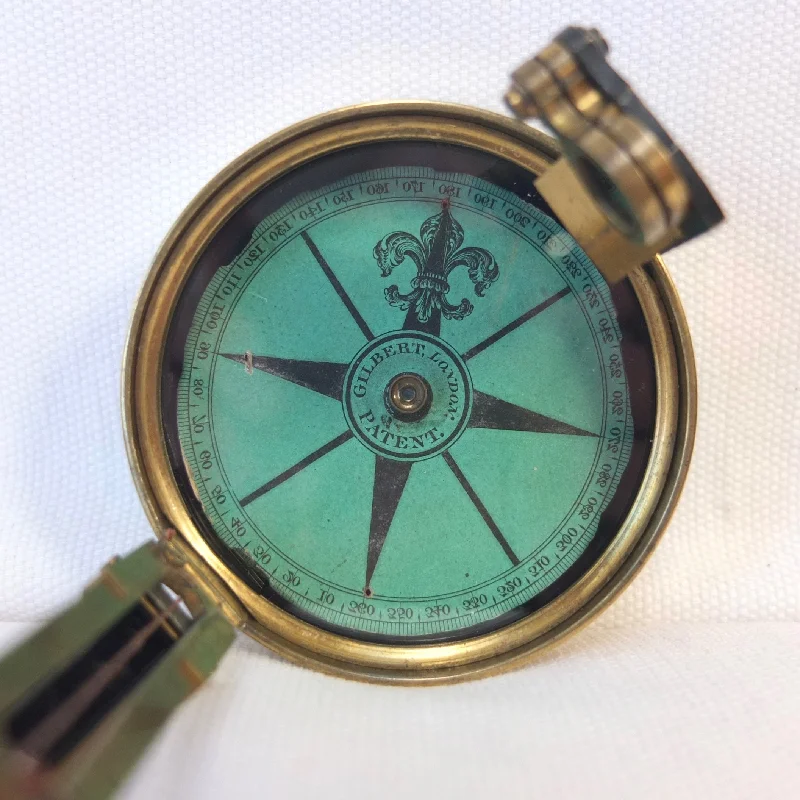A very rare Gilbert Patent prismatic compass, made in London c.1815. The compass card is marked 'Gilbert Patent, London'. The Gilbert family were well known scientific instrument makers in London from the middle of the 18th century to the late 1830's, working first from premises at Tower Hill, and later from Leadenhall Street. Several generations of the family were involved in the business, and this compass was made during the period the company was run by the brothers William and Thomas Gilbert, who worked together at 148 Leadenhall Street from around 1813 to 1828.
The compass is a variation of the Schmalcalder type, with a hand-drawn green compass card, a very unusual two piece, screw-threaded, brass case, a prism with coloured filters, and vane sights with a sliding black mirror. Another most unusual feature of this compass is the transit lock, which is operated by a spring loaded bearing that is engaged when the two parts of the case are screwed together.
The Gilbert Family: During the 18th and early 19th centuries the Gilbert family were one of the most highly respected London scientific instrument makers. The first member of the family dynasty to establish himself in the business was John Gilbert Snr, who started out as an apprentice in 1709 and began trading under his own name in 1716. His son, also John Gilbert, followed him into the business, which traded as Gilbert & Son in the 1740s. In turn, his sons John and William entered the business in the 1760s, with William also working as an apprentice to the Dollond family. William took over the business in the 1770s. After a complex series of partnerships with other makers in the late 18th century, the company became known as Gilbert & Sons around 1806, when William's sons (William and Thomas) entered the business. When the elder William Gilbert died in 1819 the company name changed again to W & T Gilbert, and they were appointed as the main supplier of instruments to the East India Company. They also supplied instruments to the Admiralty. Despite these lucrative contracts, the company went bankrupt in 1828. The Gilberts continued trading through the 1830s, continuing to supply the East India Company until 1838. By 1845 the company had ceased trading, most probably as a result of the death of William Gilbert.
(The above information is based on the excellent profile of the Gilbert family which can be found at jasonclarkantiques.co.uk, along with much other fascinating information on rare scientific instruments and their makers)
Charles Augustus Schmalcalder (1781-1843) was one of the most significant figures in the development of the compass. His patent design of 1812, which introduced the idea of using an optical prism, combined with a sighting vane, to improve accuracy when taking bearings, is still in use today. Schmalcalder's innovation was a development of the work of Henry Kater. In 1811 Kater developed a design using a mirror and sighting vane. His design was then manufactured by Thomas Jones. Schmalcalder, who also knew Thomas Jones, is believed to have seen Kater's new compass at Jones' premises, and this gave him the idea for his own prismatic version. Schmalcalder moved swiftly to have prototypes of his own design made by Jones, which he then went on to patent. Between 1812 and 1826 (when the patent expired) Schmalcalder's Patent compasses were manufactured by third party makers, like Thomas Jones, and sold from Schmalcalder's premises, first at 82 The Strand, London (1810-1826), and later from 399 The Strand, London. Schmalcalder's design was also used uncredited by many other makers, such as Simms, Barker, Gilbert, Jones, and Troughton.
(Much of the above information on Schmalcalder is based on the extensive research and expert knowledge of Paul Crespel at trademarklondon.com, who has always been very generous with his helpful and invaluable advice. For more information on Schmalcalder, Kater and the development of the early prismatic compass, see his excellent trademarklondon.com website).
Condition:
In very good, original condition, and good working order. The compass finds North well. There is some wear to the original finish of the brass case. The two sections of the case screw together correctly. The glass, sighting vane, filters, and prism are all in good condition. The compass card is in good condition, with some wear to the edges. The transit lock is working well.
Dimensions: 79mm diameter, 35mm height

